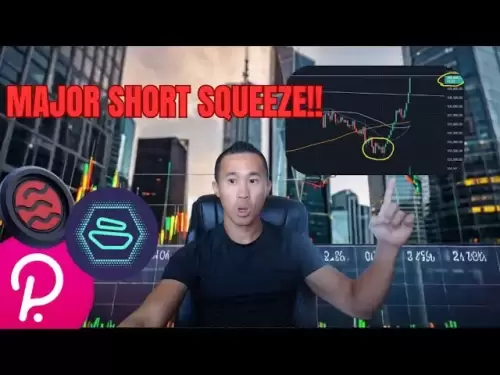-
 Bitcoin
Bitcoin $109,177.6326
2.53% -
 Ethereum
Ethereum $2,584.8670
5.97% -
 Tether USDt
Tether USDt $1.0004
0.02% -
 XRP
XRP $2.2647
3.51% -
 BNB
BNB $661.1888
1.65% -
 Solana
Solana $155.2711
4.46% -
 USDC
USDC $0.9999
0.00% -
 TRON
TRON $0.2828
0.62% -
 Dogecoin
Dogecoin $0.1726
7.64% -
 Cardano
Cardano $0.5955
7.45% -
 Hyperliquid
Hyperliquid $39.9138
5.49% -
 Sui
Sui $2.9523
9.42% -
 Bitcoin Cash
Bitcoin Cash $503.7709
-0.42% -
 Chainlink
Chainlink $13.7043
5.12% -
 UNUS SED LEO
UNUS SED LEO $8.9817
0.37% -
 Avalanche
Avalanche $18.9418
8.05% -
 Stellar
Stellar $0.2421
4.49% -
 Toncoin
Toncoin $2.8918
3.49% -
 Shiba Inu
Shiba Inu $0.0...01203
5.45% -
 Litecoin
Litecoin $89.0597
5.79% -
 Hedera
Hedera $0.1581
7.76% -
 Monero
Monero $323.4281
2.68% -
 Polkadot
Polkadot $3.6028
8.03% -
 Bitget Token
Bitget Token $4.6083
2.64% -
 Dai
Dai $1.0000
0.01% -
 Ethena USDe
Ethena USDe $1.0001
-0.01% -
 Uniswap
Uniswap $7.4784
8.36% -
 Pepe
Pepe $0.0...01043
10.49% -
 Aave
Aave $279.1304
7.36% -
 Pi
Pi $0.4971
1.95%
How to make money with Huobi leverage
Leverage trading on Huobi can be lucrative, but requires meticulous risk management to magnify profits while mitigating potential losses.
Nov 19, 2024 at 06:04 pm

How to Make Money with Huobi Leverage
Leverage trading is a powerful tool that can magnify both profits and losses. When used correctly, it can be a great way to increase your returns. However, it is important to understand the risks involved before you start trading with leverage.
What is Leverage?
Leverage is a loan that allows you to trade with more money than you have in your account. For example, if you have $100 in your account and you trade with 10x leverage, you will be able to trade with $1,000.
How Does Leverage Work?
When you trade with leverage, the exchange will lend you the additional funds that you need. You will then use these funds to open a position. If the position moves in your favor, you will make a profit. However, if the position moves against you, you will lose money.
The Risks of Leverage
Leverage can magnify both profits and losses. This means that you can make a lot of money with leverage, but you can also lose a lot of money. It is important to understand the risks involved before you start trading with leverage.
How to Use Leverage Safely
If you want to use leverage safely, you need to follow these rules:
- Only trade with leverage that you can afford to lose. This means that you should never trade with more money than you can afford to lose.
- Start with a small amount of leverage. As you gain experience, you can gradually increase the amount of leverage that you use.
- Use stop-loss orders. Stop-loss orders will help you to limit your losses if the market moves against you.
- Manage your risk. This means that you should always be aware of the risks involved in trading with leverage.
How to Make Money with Huobi Leverage
There are a number of ways to make money with Huobi leverage. Here are a few examples:
- Scalping: Scalping is a short-term trading strategy that involves buying and selling an asset within a short period of time. Scalpers use leverage to increase their profits.
- Day Trading: Day trading is a trading strategy that involves buying and selling an asset within a single day. Day traders use leverage to increase their profits.
- Swing Trading: Swing trading is a trading strategy that involves holding an asset for a few days or weeks. Swing traders use leverage to increase their profits.
- Long-term Trading: Long-term trading is a trading strategy that involves holding an asset for a period of months or years. Long-term traders use leverage to increase their profits.
Conclusion
Leverage can be a powerful tool for increasing your profits, but it is important to understand the risks involved before you start trading with leverage. If you use leverage safely, you can make a lot of money. However, if you do not use leverage safely, you can lose a lot of money.
Disclaimer:info@kdj.com
The information provided is not trading advice. kdj.com does not assume any responsibility for any investments made based on the information provided in this article. Cryptocurrencies are highly volatile and it is highly recommended that you invest with caution after thorough research!
If you believe that the content used on this website infringes your copyright, please contact us immediately (info@kdj.com) and we will delete it promptly.
- Meme Coin Mania: Is BTC Bull the Next Big Thing in a Limited Time BTC Bull Run?
- 2025-07-03 12:30:11
- Bitcoin Soars to $109,000: What's Fueling the Crypto Rally?
- 2025-07-03 10:30:13
- Splatterhouse Rocks Retro Scene: A UK Magazine Deep Dive
- 2025-07-03 12:30:11
- Bitcoin, the Senate Bill, and $107K: A Wild Ride on Capitol Hill
- 2025-07-03 12:50:11
- Chainlink's Chart Patterns Hint at a Big Move: Decoding the LINK Price
- 2025-07-03 10:50:12
- Shiba Inu, Solana Uptrend, Bitcoin Breakout: Decoding the Crypto Buzz
- 2025-07-03 10:50:12
Related knowledge

How to identify the contract value range in combination with the market profile?
Jul 02,2025 at 10:56pm
Understanding the Market ProfileTo effectively identify the contract value range in combination with the market profile, it's essential to first understand what each concept entails. The market profile is a framework that helps traders visualize how price and time interact across a given period, typically a trading day or session. It provides insights i...

How to use the price slope to filter the false breakthrough signal of the contract?
Jun 20,2025 at 06:56pm
Understanding the Concept of Price Slope in Contract TradingIn contract trading, especially within cryptocurrency derivatives markets, price slope refers to the rate at which the price changes over a specific time period. It helps traders assess the strength and sustainability of a trend. A steep slope may indicate strong momentum, while a shallow slope...

How to determine the expected volatility of the contract through the volatility cone?
Jun 19,2025 at 12:28pm
Understanding the Basics of Volatility in Cryptocurrency ContractsIn the realm of cryptocurrency trading, volatility is a key metric that traders use to assess potential risk and reward. When dealing with futures contracts, understanding how volatile an asset might become over time is crucial for position sizing, risk management, and strategy developmen...

How to formulate a contract intraday trading plan in combination with the pivot point system?
Jun 21,2025 at 03:42pm
Understanding the Basics of Pivot Points in Cryptocurrency TradingPivot points are technical analysis tools used by traders to identify potential support and resistance levels. These levels are calculated using the previous day's high, low, and closing prices. In the context of cryptocurrency trading, where markets operate 24/7, pivot points help trader...

How to adjust the contract position ratio through the price fluctuation entropy?
Jun 22,2025 at 11:42am
Understanding Price Fluctuation Entropy in Cryptocurrency ContractsIn the world of cryptocurrency futures trading, price fluctuation entropy is a relatively new concept used to measure market volatility and uncertainty. It derives from information theory, where entropy refers to the degree of randomness or unpredictability in a system. In crypto contrac...

How to use the volume swing indicator to predict the contract volume-price divergence?
Jun 18,2025 at 11:42pm
Understanding the Volume Swing IndicatorThe volume swing indicator is a technical analysis tool used primarily in cryptocurrency trading to evaluate changes in volume over time. Unlike price-based indicators, this metric focuses solely on trading volume, which can provide early signals about potential market reversals or continuations. The key idea behi...

How to identify the contract value range in combination with the market profile?
Jul 02,2025 at 10:56pm
Understanding the Market ProfileTo effectively identify the contract value range in combination with the market profile, it's essential to first understand what each concept entails. The market profile is a framework that helps traders visualize how price and time interact across a given period, typically a trading day or session. It provides insights i...

How to use the price slope to filter the false breakthrough signal of the contract?
Jun 20,2025 at 06:56pm
Understanding the Concept of Price Slope in Contract TradingIn contract trading, especially within cryptocurrency derivatives markets, price slope refers to the rate at which the price changes over a specific time period. It helps traders assess the strength and sustainability of a trend. A steep slope may indicate strong momentum, while a shallow slope...

How to determine the expected volatility of the contract through the volatility cone?
Jun 19,2025 at 12:28pm
Understanding the Basics of Volatility in Cryptocurrency ContractsIn the realm of cryptocurrency trading, volatility is a key metric that traders use to assess potential risk and reward. When dealing with futures contracts, understanding how volatile an asset might become over time is crucial for position sizing, risk management, and strategy developmen...

How to formulate a contract intraday trading plan in combination with the pivot point system?
Jun 21,2025 at 03:42pm
Understanding the Basics of Pivot Points in Cryptocurrency TradingPivot points are technical analysis tools used by traders to identify potential support and resistance levels. These levels are calculated using the previous day's high, low, and closing prices. In the context of cryptocurrency trading, where markets operate 24/7, pivot points help trader...

How to adjust the contract position ratio through the price fluctuation entropy?
Jun 22,2025 at 11:42am
Understanding Price Fluctuation Entropy in Cryptocurrency ContractsIn the world of cryptocurrency futures trading, price fluctuation entropy is a relatively new concept used to measure market volatility and uncertainty. It derives from information theory, where entropy refers to the degree of randomness or unpredictability in a system. In crypto contrac...

How to use the volume swing indicator to predict the contract volume-price divergence?
Jun 18,2025 at 11:42pm
Understanding the Volume Swing IndicatorThe volume swing indicator is a technical analysis tool used primarily in cryptocurrency trading to evaluate changes in volume over time. Unlike price-based indicators, this metric focuses solely on trading volume, which can provide early signals about potential market reversals or continuations. The key idea behi...
See all articles

























































































